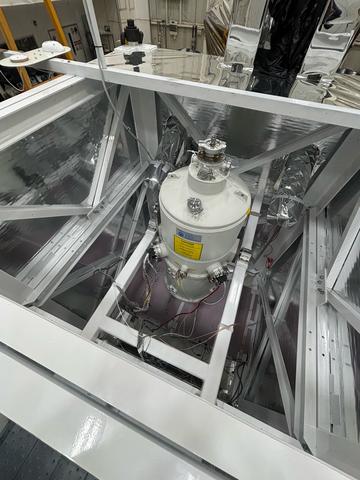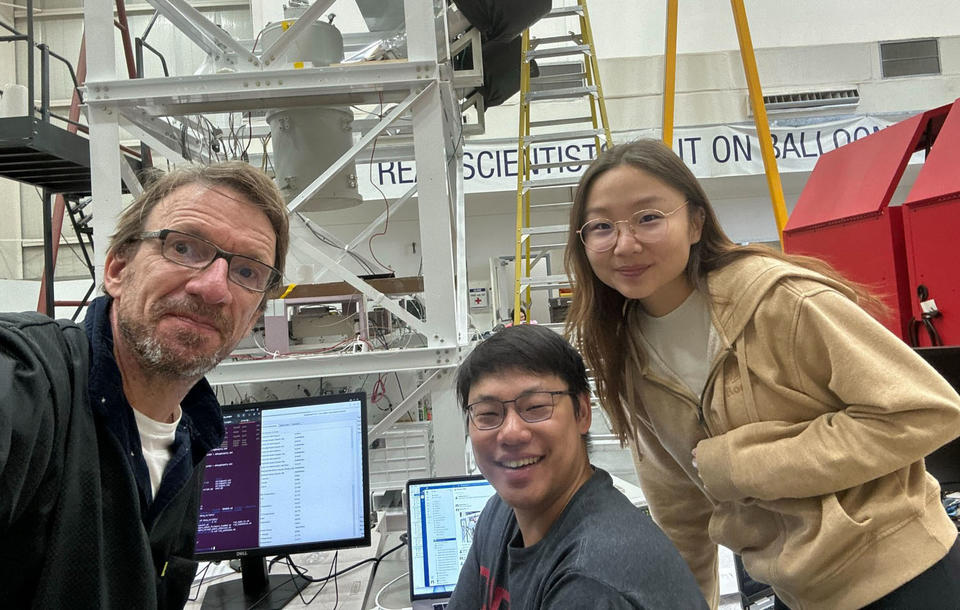Taking Measure
Just a Standard Blog

A side view of the nearly flight-ready experiment, hanging underneath the connector that attached to the balloon. Some of the computers used in the experiment can be seen in the uncovered section at the bottom.
There’s a hole in the bottom of the sea. … At least, that’s how I remember the children’s song starting off.
Each verse of the song would pile another item into the hole at the bottom of the sea, culminating in something ridiculous. The song would result in something like, “There’s a bug on a car, on a house, on a log, on a frog in a hole at the bottom of the sea.”
That song floated back into my mind as I recalled my adventure in the New Mexico desert last summer.
NIST had previously developed tools called transition edge sensors (TES), which only work at extremely cold temperatures. Researchers use these sensors to study anything from a remnant of the Big Bang, known as the cosmic microwave background, to X-rays and gamma-rays coming from distant supernovas and black holes.
I study physics at Washington University in St. Louis. In collaboration with NIST, we wanted to place these sensors — and a scientific refrigerator needed to cool them down — onto a balloon that would fly high above most of Earth’s atmosphere. If I were to summarize our efforts, I might modify the song to go something like this:
There are superconductors in a box under a fridge in a cryostat on a gondola under a balloon at the top of the sky.
There are superconductors in a box …
TESs are superconductors (well, not just a superconductor, but the superconductor is one of its key components) that allow us to see radiation known as gamma rays and measure their energy with very high precision. It’s like a cutting-edge camera, but we use it to take pictures of light that is tens of thousands of times as energetic as the light our eyes see every day.
We love how the cameras in our cellphones provide cleaner and crisper pictures each year. Likewise, astrophysicists work hard to get better pictures of gamma rays coming from celestial objects such as black holes and neutron stars, which produce lots of this radiation.
Our gamma-ray camera consists of many TESs, all held within our “detector box.”
… under a fridge in a cryostat on a gondola under a balloon at the top of the sky.
To keep the TESs at just the right temperature for them to work, we need to bring them to a fraction of a degree above absolute zero, which is around minus 273 degrees Celsius or minus 459 degrees Fahrenheit — colder than outer space!

Fortunately, we have plenty of scientific dilution refrigerators (DRs) that can easily achieve such temperatures in the lab. Less fortunately, though, they are often quite large, spanning the width and height of a normal lab room. And we can only collect the necessary X-rays or gamma rays at about 40 kilometers (25 miles) into the sky because the closer we get to Earth’s surface, the more the photons are blocked out by the atmosphere. That’s roughly three to four times the height at which a commercial airplane flies.
Therefore, we wanted to see if a miniature DR could be flown on a science balloon at such a height and if it could successfully cool the TESs while in the sky. That’s quite the logistical challenge!
We situated both the TES detector box and the mini-DR within our airtight chamber to maintain extremely low temperatures. (We call this airtight chamber a “cryostat.”) The cryostat first took the equipment down to the “easy” temperature of 4 kelvin (roughly, a balmy minus 269 degrees Celsius or minus 452 degrees Fahrenheit). Then, the mini-DR took it the rest of the way to 100 millikelvins (a fraction of 1 degree Fahrenheit above a temperature of absolute zero).
Finally, we loaded the cryostat onto a sturdy, rigid metal frame we call the “gondola.” We mounted the gondola beneath the science balloon.
And then we needed to actually launch the balloon.
Stepping back a bit:
As we labored in the desert day in and day out, our team would go to a hangar at a former Air Force base to try to put together and test the equipment for this science balloon flight.
Admittedly, when I first started my Ph.D. at Washington University in St. Louis, I had not even imagined that I would spend weeks in a tiny town in New Mexico doing this.
When I was a first-year graduate student, I didn’t even know which area of physics I wished to dive into for my degree. But one day, Henric Krawczynski, one of the professors in our physics department, came to speak at our weekly seminar class. He talked about his computations as well as his various balloon missions. Before this, I hadn’t thought I wanted to do experiments. “After all,” I thought, “don’t the driving ideas of physics come from the theories?”
But one thing stuck with me. (He didn’t say it precisely this way, but this is my takeaway.)
We have four basic forces in physics, from the strong force and the weak force to the electromagnetic force and gravity, that explain every other physical law. We can test the first three with the particle colliders here on Earth. But the best way to test the most extreme gravitational effects is a laboratory among the stars — such as around black holes and neutron stars, some of the densest objects in the universe.
But if we want to make any progress with testing the fundamentals of physics around such objects, we need to first understand them well enough. We can learn more about them by getting a clearer picture, for example, of the stuff falling into the black hole or the materials that make up the neutron star. And we can get this clearer picture by precisely measuring the gamma rays coming from these objects with TESs!
And that’s why we wanted to send a DR up with our TESs almost halfway to space to take pictures of gamma rays. We’re trying to see what clues this radiation can show us about some of the wildest, most mysterious objects in our universe — and, eventually, what that teaches us about fundamental physics laws.
Now stepping back to the present:
After we finished putting together our equipment in New Mexico, we waited for the chance to launch our balloon.
Each night that we had a potential launch opportunity, we woke up at around 9 p.m. We prepared our experiment and waited to hear whether the 1 a.m. decision from NASA’s Columbia Science Ballooning Facility would clear us for launch. Multiple times, they called us off, as they decided that another balloon mission would go first.

Even for the first-in-line balloon mission, so many things had to go right before an actual launch. Here are just a few of the factors:
- The wind on the ground and at the height of the massive balloon had to be calm enough.
- There couldn’t be any rain.
- NASA had to calculate a less than 0.01% chance of the balloon and equipment hitting a person during the flight. (Fear not, reader, you are in safe hands.)
Each time when NASA called off our launch attempt in favor of another mission, we had to repeat all of our preparations again the following night.
Our day (or night) came at last, with the queue finally emptied of all other missions. Anything could still have gone wrong, canceling our launch. This had happened 14 times on another balloon mission of ours. I feared the worst.
But instead, when our turn came, we launched on the first try!
Our findings — and what’s next?
During this flight, we demonstrated that our detector box could indeed measure the desired radiation. We even achieved a temperature of around 90 millikelvins above absolute zero at the detector box during flight!
However, we did not manage to get the temperature quite as stable as needed to get the state-of-the-art energy resolution that we can already get from TESs on the ground. We could work on this in our lab back in St. Louis and fly again from New Mexico.
Personally, I’ve learned quite a bit, both about the science of these detectors and about this whole process of scientific ballooning. Over the past few years, I’ve gained a much deeper appreciation and understanding of the experimental side of astrophysics. We can theorize all we want, but without taking actual data, we’ll never know reality from mere possibilities.
I also now know how much effort it takes to get a balloon mission to work! But I’ve also experienced the rewards of success, especially while working with so many others (including our pivotal collaborators at the University of New Hampshire and at NIST) to get something to work for the very first time.
Ending with a bang!
People often ask me: How does the balloon come down? Can you control where it lands?
Sadly, we can only take out a balloon of that volume by sending it up with explosives and blowing it up before allowing the science equipment hanging beneath the balloon to fall to Earth underneath a parachute. (That sounds scary, but NASA prioritizes safety in the descent calculations, just as it does prior to launch.)
Remember the song from the beginning? At this point, I might change my tune one last time, to go something like this:
There’s a hole in the balloon carrying a gondola carrying a cryostat containing a fridge cooling a box full of superconductors at the top of the sky —
— at least, right before it plummets.
About the author
Related Posts
Comments
Thank you for the work you do. I did have questions about why you needed such remarkable cryogenic sensors, to detect such powerful (high-energy) short wavelengths. I was also curious about any optics or reflectors, and how/if you pointed the detectors at a particular point/region in space, and how you managed to do that while beneath a balloon.
Thx.
Thanks very much for reading, and thanks for your questions!
1) For X-ray and gamma-ray instruments, we are generally looking to improve the resolution in each of these areas: energy resolution, angular/spatial resolution, and time resolution---more information in any of these aspects will help us get a more complete picture of the astrophysical sources we're planning to look at. For example, using these remarkable TES sensors, with their amazing energy resolution, to look at X-rays will help us be able to better understand what's going on inside a supernova (this paper of ours describes it a bit more, if one is interested! https://arxiv.org/abs/2301.01525).
2) For this particular mission (DR-TES), we do not use any optics or pointing. However, another mission (XL-Calibur: https://arxiv.org/abs/2204.09761; https://arxiv.org/abs/2010.10608) of ours indeed does use grazing incidence mirrors and a pointing system. The pointing system for that mission is done with the excellent Wallops Arc-Second Pointer (https://arc.aiaa.org/doi/10.2514/6.2017-3609) from NASA!






1. Try adding a (2 or more) remote controlled device(s) to balloon to use to trigger remotely the devices to slowly let the air or whatever gas you have in balloon out, but slowly. Allowing it to descend slowly to the touchdown area that you have pre selected based on wind predictions and maps and safe landing zones near the location of the ballon when your tests are done. Thus saving ballon, equipment, etc… from major damage. And possible reuse. Saving $ budget. Keep up the good work on your experiments! Learn as much as you can, please! 🙏 Stretch your budget $ dollars by not buying explosives, please 🙏.
I’m praying for your successes! Don’t give up!